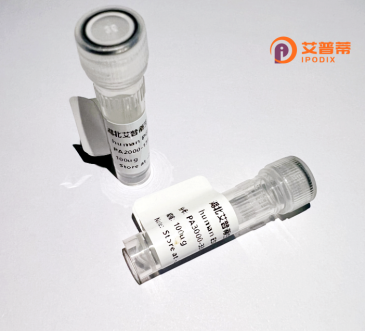
| 纯度 | >90%SDS-PAGE. |
| 种属 | Human |
| 靶点 | ARS2 |
| Uniprot No | Q9BXP5 |
| 内毒素 | < 0.01EU/μg |
| 表达宿主 | E.coli |
| 表达区间 | 1-876aa |
| 氨基酸序列 | MGDSDDEYDRRRRDKFRRERSDYDRSRERDERRRGDDWNDREWDRGRERRSRGEYRDYDRNRRERFSPPRHELSPPQKRMRRDWDEHSSDPYHSGYEMPYAGGGGGPTYGPPQPWGHPDVHIMQHHVLPIQARLGSIAEIDLGVPPPVMKTFKEFLLSLDDSVDETEAVKRYNDYKLDFRRQQMQDFFLAHKDEEWFRSKYHPDEVGKRRQEARGALQNRLRVFLSLMETGWFDNLLLDIDKADAIVKMLDAAVIKMEGGTENDLRILEQEEEEEQAGKPGEPSKKEEGRAGAGLGDGERKTNDKDEKKEDGKQAENDSSNDDKTKKSEGDGDKEEKKEDSEKEAKKSSKKRNRKHSGDDSFDEGSVSESESESESGQAEEEKEEAEEALKEKEKPKEEEWEKPKDAAGLECKPRPLHKTCSLFMRNIAPNISRAEIISLCKRYPGFMRVALSEPQPERRFFRRGWVTFDRSVNIKEICWNLQNIRLRECELSPGVNRDLTRRVRNINGITQHKQIVRNDIKLAAKLIHTLDDRTQLWASEPGTPPLPTSLPSQNPILKNITDYLIEEVSAEEEELLGSSGGAPPEEPPKEGNPAEINVERDEKLIKVLDKLLLYLRIVHSLDYYNTCEYPNEDEMPNRCGIIHVRGPMPPNRISHGEVLEWQKTFEEKLTPLLSVRESLSEEEAQKMGRKDPEQEVEKFVTSNTQELGKDKWLCPLSGKKFKGPEFVRKHIFNKHAEKIEEVKKEVAFFNNFLTDAKRPALPEIKPAQPPGPAQILPPGLTPGLPYPHQTPQGLMPYGQPRPPILGYGAGAVRPAVPTGGPPYPHAPYGAGRGNYDAFRGQGGYPGKPRNRMVRGDPRAIVEYRDLDAPDDVDFF |
| 分子量 | 100 kDa |
| 蛋白标签 | His tag N-Terminus |
| 缓冲液 | 冻干粉 |
| 稳定性 & 储存条件 | Lyophilized protein should be stored at ≤ -20°C, stable for one year after receipt. Reconstituted protein solution can be stored at 2-8°C for 2-7 days. Aliquots of reconstituted samples are stable at ≤ -20°C for 3 months. |
| 复溶 | Always centrifuge tubes before opening.Do not mix by vortex or pipetting. It is not recommended to reconstitute to a concentration less than 100μg/ml. Dissolve the lyophilized protein in distilled water. Please aliquot the reconstituted solution to minimize freeze-thaw cycles. |
以下是关于重组人Arrestin结构域含蛋白4(ARRDC4)的参考文献及摘要概括:
1. **标题**:"ARRDC4 Regulates Exosome Biogenesis by Mediating TSG101 Sorting to the Endosome"
**作者**:Nabhan JF, Hu R, Oh RS, et al.
**摘要**:该研究揭示了ARRDC4通过其Arrestin结构域与TSG101(肿瘤易感基因101)相互作用,调控外泌体的生物发生。ARRDC4在膜微结构(ARMMs)的形成中起关键作用,影响外泌体介导的细胞间通讯,提示其在肿瘤微环境中的潜在功能。
2. **标题**:"Arrestin Domain-Containing Protein 4 Modulates Insulin Signaling and Glucose Homeostasis"
**作者**:Patwari P, Emilsson V, Schadt EE, et al.
**摘要**:研究表明,ARRDC4通过其Arrestin结构域与胰岛素受体相互作用,负调控胰岛素信号通路。在小鼠模型中,ARRDC4缺失导致胰岛素敏感性增加和糖代谢改善,提示其作为代谢疾病治疗靶点的可能性。
3. **标题**:"Structural and Functional Analysis of ARRDC4 Reveals a Role in Ubiquitin Ligase Complex Assembly"
**作者**:Draheim KM, Chen Y, Tao WA, et al.
**摘要**:通过生物信息学和结构生物学分析,该文献阐明了ARRDC4的N端Arrestin结构域介导与E3泛素连接酶的互作,参与泛素-蛋白酶体通路,调控细胞增殖和凋亡相关蛋白的稳定性。
4. **标题**:"Downregulation of ARRDC4 in Colorectal Cancer Promotes Tumor Progression via Wnt/β-Catenin Pathway"
**作者**:Qin J, Wang Y, Zhang Y, et al.
**摘要**:研究发现ARRDC4在结直肠癌中表达下调,其过表达可抑制Wnt/β-catenin信号通路活性,减少肿瘤细胞增殖和迁移,提示ARRDC4作为潜在抑癌基因的临床意义。
上述文献涵盖了ARRDC4在膜运输、代谢调控、泛素化及癌症中的作用,反映了其多功能结构域和广泛生物学意义。
ARRDC4 (Arrestin Domain-Containing Protein 4) is a member of the α-arrestin family, a subset of arrestin-related proteins involved in regulating transmembrane receptor signaling and intracellular trafficking. Unlike β-arrestins, which primarily modulate G protein-coupled receptors (GPCRs), α-arrestins like ARRDC4 are associated with broader roles, including ubiquitination-mediated protein degradation and endosomal sorting. ARRDC4 contains a conserved arrestin-fold domain and PPXY motifs that facilitate interactions with WW domain-containing E3 ubiquitin ligases, such as NEDD4 or ITCH, linking it to the ubiquitin-proteasome system.
Functionally, ARRDC4 participates in cellular processes like vesicular transport, receptor internalization, and signaling pathway modulation. Studies suggest its involvement in metabolic regulation, inflammation, and cancer progression. For instance, ARRDC4 has been implicated in suppressing tumor growth by promoting the degradation of oncogenic receptors, though its role appears context-dependent. In immune regulation, it may influence cytokine signaling by targeting receptors for lysosomal degradation.
Despite these findings, ARRDC4's precise molecular mechanisms remain less characterized compared to other arrestins. Emerging evidence highlights its potential as a therapeutic target, particularly in diseases linked to aberrant receptor signaling or protein homeostasis. Further research is needed to unravel its physiological and pathological networks, including structural studies to clarify ligand-binding specificity and tissue-specific functions.
×